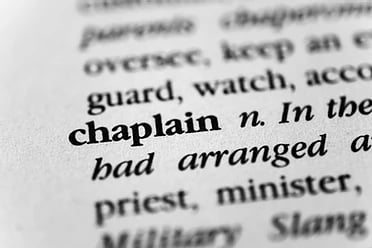Differences between Pastors and Crisis Chaplains


I've got a few nicknames around State Fire. I get called "Chaps," "Chappy," "Padre"(no, I'm not Catholic, but I go with it), and a few others that my firefighters affectionally call me that I won't repeat on this blog. But the other day, one of my co-workers called me "Pastor Wade," she was very surprised when I informed her that I wasn't a pastor. Since many of the chaplains she knows in the state are also pastors of local churches, she figured that being a chaplain was synonymous with being a pastor. While there are some similarities between being a pastor and a chaplain, I went on to show her that there are some fundamental differences, too.
Chaplain ministry, especially those chaplains that directly work for the government (paid or unpaid), walk the line between the two sides of the religion clause in the Constitution's First Amendment (Establishment and Free Exercise). In the process, the US Supreme Court has declared that chaplaincy is a legitimate function of the government when done correctly. We tend to see lawsuits and chaplain programs disbanded when chaplaincy is done wrong.
I shared some main differences between a pastor and a governmental crisis chaplain with my friend.
Pastors
Works for a local church or congregation
Is concerned about ministering to those of his/her own faith or helping covert people to his/her faith.
Works mostly within the church walls or at least with people of like-minded faith. Speaks on behalf of the congregation
Deals with doctrines, rituals, and beliefs specific to a faith. They may deal in counseling that is in line with their faith outlook.
Is more in line with separation of church and state according to the First Amendment
Government sees as primarily religious in nature.
Deals with rituals and services
Usually, must stay outside the emergency response situation.
Chaplains
Works for government, business, or private organization. May be ordained, but this is not necessarily the concern of the state.
May be just about any faith and works with people of many faiths. Normally does not share their faith unless asked. But the chaplain is free to talk about their faith, just as anyone else is.
Works in the marketplace among people of many faiths. The chaplain is not expected to “check their faith at the workplace door” when they come to work but cannot impose it on others or speak in faith on behalf of others.
Deals more with ethical behavior and in the case of police and fire, crisis response. A chaplain listens more than he/she talks though counseling is a part of their job. A chaplain may be trained in different types of counseling and walks with people as they live out their lives.
Walks a balance between the establishment clause and the free exercise clause of the First Amendment. Supreme Court has established that government funded chaplaincy does not violate the First Amendment.
Government sees chaplaincy as secular in nature but does allow limited entanglement where the benefit of the state is secular in nature and is perceived by the public as secular in nature.
May be involved in limited rituals and services depending on the type of chaplaincy. The government funds many types of chaplaincies. Where the government restricts the movement of people (military, prison) the government uses chaplains to help people with the Free Exercise Clause. Where the government does not restrict the movement (fire, police) the government adheres more to the establishment clause, even though there may be limited entanglement to carry out the chaplain’s duties.
Is usually involved in immediate crisis intervention. Is part of the police/fire response and is free to move within the emergency response situation as training and protocols allow.
Often trained in crisis response and trauma
The US Supreme Court has given us guidance to see if any government action (including chaplaincy) violates the establishment clause of the First Amendment. In Lemon v. Kurtzman, the US Supreme Court set forth three tests that are the modern standard for government chaplaincy. An answer to any of these tests in the negative means such action will not stand up to judicial review. These tests are:
Does the challenged law or other action by the government have a bona fide secular or civic purpose?
Does the primary effect of the law or action by the government neither advance nor inhibit religion? Is it neutral?
Does the law or action by the government avoid excessive entanglement of the government with religion?
When the chaplains are workers for a para-church or non-governmental organization, they can have more freedom because they are not government employees, just contractors. But, when representing the government, yet being a non-governmental entity, the public only sometimes knows who they represent. They can give the perception that there is a governmental endorsement of religion, which would be violating the First Amendment. In this case, the excessive entanglement portion of the Lemon ruling can act as an early warning system for the possibility of a violation of the Establishment Clause.
Even with the restrictions, the government crisis chaplain has some wonderful opportunities. As a police/fire/crisis response chaplain, we can take care of people facing their worst crisis and have access to go where the public cannot. We also get to walk with and help first responders as they navigate their sometimes-painful jobs and lives. And as chaplains, even though we share some similarities with pastors, ours is a unique and wonderful calling that allows us to go where no other can.
